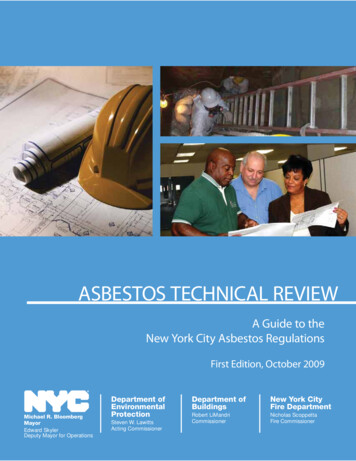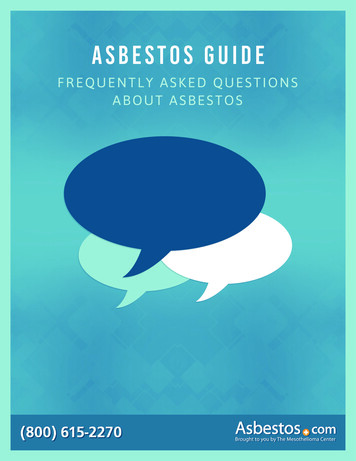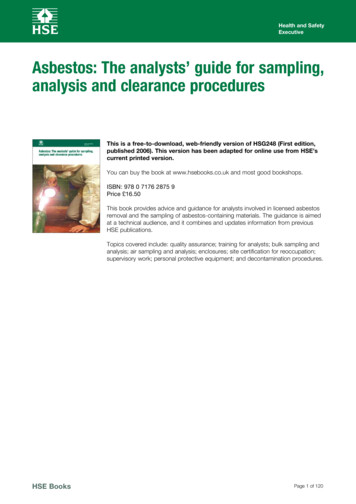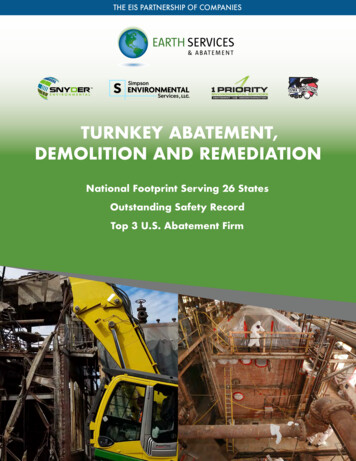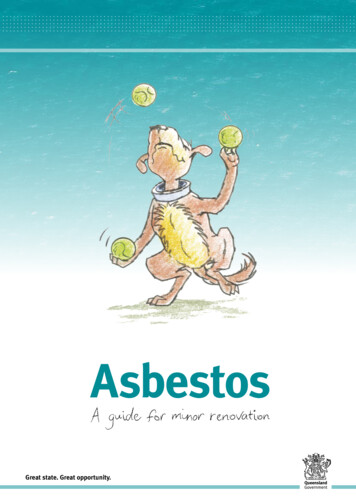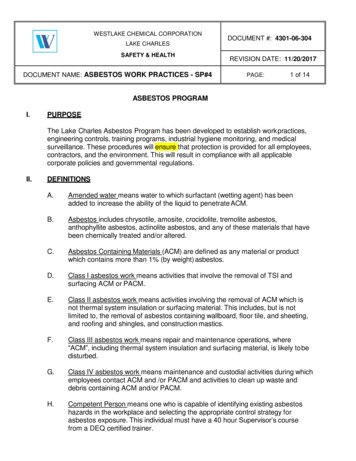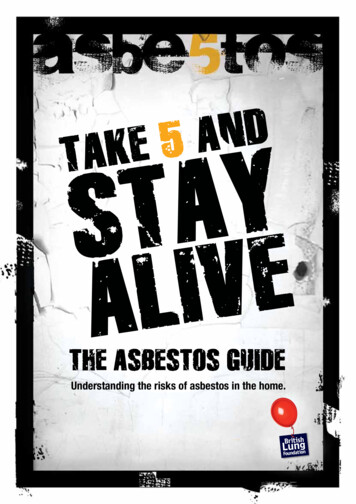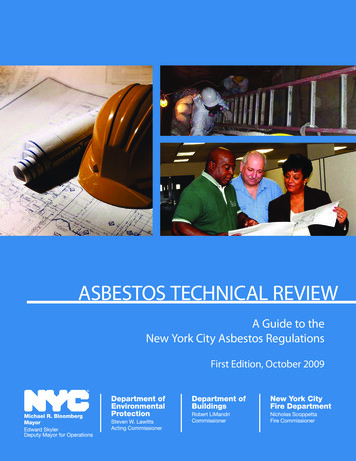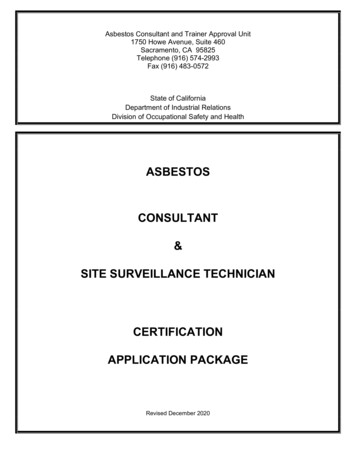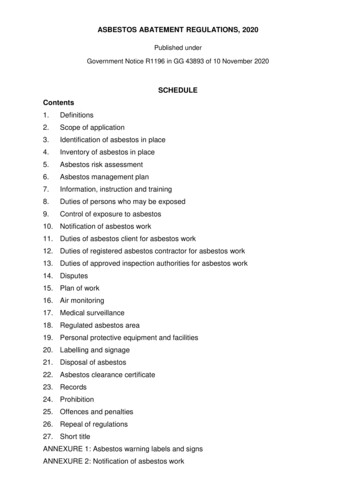
Transcription
ASBESTOS ABATEMENT REGULATIONS, 2020Published underGovernment Notice R1196 in GG 43893 of 10 November 2020SCHEDULEContents1.Definitions2.Scope of application3.Identification of asbestos in place4.Inventory of asbestos in place5.Asbestos risk assessment6.Asbestos management plan7.Information, instruction and training8.Duties of persons who may be exposed9.Control of exposure to asbestos10. Notification of asbestos work11. Duties of asbestos client for asbestos work12. Duties of registered asbestos contractor for asbestos work13. Duties of approved inspection authorities for asbestos work14. Disputes15. Plan of work16. Air monitoring17. Medical surveillance18. Regulated asbestos area19. Personal protective equipment and facilities20. Labelling and signage21. Disposal of asbestos22. Asbestos clearance certificate23. Records24. Prohibition25. Offences and penalties26. Repeal of regulations27. Short titleANNEXURE 1: Asbestos warning labels and signsANNEXURE 2: Notification of asbestos work
2Definitions1.In these Regulations any word or expression to which a meaning has beenassigned in the Act has the meaning so assigned and, unless the context otherwiseindicates—"approved plan of work" means a written site-specific methodology ascontemplated in regulation 15 that is at least co-signed by the asbestos client,registered asbestos contractor and approved inspection authority;"asbestos" means the following fibrous silicates:(a)Asbestos actinolite, CAS No. 77536-66-4;(b)asbestos grunerite (amosite), CAS No. 12172-73-5;(c)asbestos anthophyllite, CAS No. 77536-67-5;(d)chrysotile, CAS No. 12001-29-5 or CAS No. 132207-32-0;(e)crocidolite, CAS No. 12001-28-4;(f)asbestos tremolite, CAS No. 77536-68-6; and(g)any mixture containing these fibrous silicates;"asbestos cement products" means a range of building materials that weremanufactured using moulding and compression techniques, consisting of a hardenedmixture of asbestos fibres, cement and water;"asbestos clearance certificate" means a written document verifying that theregulated asbestos fibre concentration in the air meets the clearance indicator;"asbestos client" means any person for whom asbestos work is performed;"asbestos coating" means a surface coating which contains asbestos for fireprotection, heat insulation or sound insulation, but does not include textureddecorative coatings;"asbestos-containing material" means asbestos as well as any material thatcontains asbestos and includes asbestos cement products, asbestos coating,asbestos insulation board, asbestos insulation, asbestos textured decorativecoatings, asbestos contaminated soil and other asbestos-containing materials;"asbestos disposal site" means a site specifically designated for the purpose ofasbestos disposal in terms of the National Environmental Management: Waste Act,2008 (Act No. 59 of 2008);
3"asbestos dust" means airborne or settled dust, which contains or is likely tocontain regulated asbestos fibres;"asbestos in place" includes any asbestos, asbestos cement products, asbestoscoatings, asbestos-containing material, asbestos dust, asbestos insulation, asbestosinsulation board and asbestos waste at the workplace;"asbestos insulation" means any asbestos-containing material, which is used forthermal, acoustic or other insulation purposes, including fire protection, except—(a)asbestos cement, asbestos coating or asbestos insulating board;or(b)any article of bitumen, plastic, resin or rubber, which containsasbestos and which thermal and acoustic properties areincidental to its main purpose;"asbestos insulating board" means any flat sheet, tile or building board consistingof a mixture of asbestos and cement or any other material, but which is not-—(a)asbestos coating; or(b)an article of bitumen, plastic, resin or rubber, which containsasbestos and which thermal and acoustic properties areincidental to its main purpose;"asbestos removal site" means a workplace where asbestos removal work isperformed;"asbestos removal supervisor" means a competent person responsible forsupervision of physical asbestos work processes and coordination of asbestosremoval on an asbestos removal site;"asbestos risk assessment" means a risk assessment and risk categorisation ofpotential exposure to asbestos dust;"asbestos waste" means an undesirable or superfluous asbestos or asbestoscontaining product or by-product or the undesirable or superfluous asbestos orasbestos-containing emission or residue of any process or activity, which hasbeen—(a)discarded by any person; or
4(b)accumulated and stored temporarily with the purpose ofdiscarding it, with or without prior treatment connected with thediscarding thereof;"asbestos work" means work that exposes or is likely to expose an employee toasbestos dust, including transporting, storing, removing, handling, treating, repairingand disposing of asbestos;"CAS No." means the Chemical Abstracts Service Registry Number;"Chief Director: Provincial Operations" means the provincial director as defined inregulation 1 of the General Administrative Regulations, 2003, published asGovernment Notice R.929 in Gazette No. 25129 of 25 June 2003;"clearance indicator" means the measured airborne concentration of regulatedasbestos fibres is less than 0,01 fibres per millilitre (f/ml), as measured inaccordance with HSG 248 or an equivalent method;"competent person" means a person who—(a)has, in respect of the work or task to be performed, the requiredknowledge, training and experience and, where applicable,qualifications specific to asbestos work or related tasks: Providedthat, where appropriate qualifications and training are registeredin terms of the National Qualifications Framework Act, 2008 (ActNo. 67 of 2008), those qualifications and that training must beregarded as the required qualifications and training; and(b)is familiar with the Act and the applicable regulations made underthe Act;"demolition work" means a method to dismantle, wreck, break, pull down or knockdown a structure or part thereof by way of manual labour, machinery or the use ofexplosives;"environmental air monitoring" includes static air monitoring for regulated fibresconducted downwind from outdoor type 2 asbestos work or outside asbestosenclosures where type 3 asbestos work is performed or in any area where there isthe potential for asbestos contamination;
5"exposed to asbestos" means exposed or likely to be exposed to asbestos dustwhile at the workplace, and "exposure" has a corresponding meaning;"HSG 248" means Health and Safety Guidance 248: Asbestos – The Analysts'Guide for Sampling, Analysis and Clearance Procedures, published in 2005, or latestupdate;"incidental asbestos exposure" means unintentional exposure to airborneasbestos at a workplace where asbestos is present;"non-asbestos-related work" includes work performed in the vicinity of asbestoscontaining materials or asbestos cement products, but excludes work performed onor with asbestos-containing materials or asbestos cement products;"OEL" means the occupational exposure limit, the value of which is set by theMinister, for a stress factor in the workplace;"OEL for asbestos" means an occupational exposure limit of 0,1 regulatedasbestos fibres per millilitre of air measured in accordance with HSG 248;"registered asbestos contractor" means either a contractor, a mandatory or anemployer who conducts type 2 asbestos work or type 3 asbestos work or asbestosremoval work, who is registered with the chief inspector;"regulated asbestos area" means an area demarcated and controlled ascontemplated in regulation 18;"regulated asbestos fibre" means a particle of asbestos with a length-to-diameterratio greater than 3 to 1, a length greater than 5 micrometres and a diameter lessthan 3 micrometres;"removal of asbestos" means all tasks included in the process of removingasbestos from the location specified in the inventory of asbestos in place to the finaldisposal site;"repair of asbestos-containing materials" means restoring asbestos-containingmaterials to a safe condition, after damage, using non-destructive methods in amanner that does not cause the release of asbestos fibres;"respiratory protective equipment" means a device which is worn over at least themouth and nose to control the inhalation of air that is not safe;
6"risk categorisation" means the grouping and ordering of potential asbestosexposure risks as contemplated in regulation 5(3);"short-term exposure limit" means a short-term exposure limit of 0,6 regulatedasbestos fibres per millilitre of air, measured over a continuous 10-minute period;"the Act" means the Occupational Health and Safety Act, 1993 (Act No. 85 of1993);"type 1 asbestos work" means—(a)painting of asbestos cement products in a manner that does notrequire surface preparation and does not cause the release ofasbestos fibres; or(b)the removal of less than 10 square metres of asbestos cementproducts or equivalent gutters and piping or asbestos insulatingboard, where removal work may not be repeated on the same sitewithin a period of six months; and,does not require registration as a registered asbestos contractor with the chiefinspector;"type 2 asbestos work" means—(a)the repair or encapsulation of asbestos cement products in amanner that does not require surface preparation; or(b)the removal of asbestos cement products or asbestos insulatingboard; and,requires registration as a type 2 registered asbestos contractor with the chiefinspector;"type 3 asbestos work" means—(a)the removal, repair or encapsulation of any asbestos andasbestos-containing material; and,requires registration as a type 3 registered asbestos contractor with the chiefinspector;"UN Transport of Dangerous Goods" means the UN Recommendations on theTransport of Dangerous Goods – Model Regulations, Volumes 1 and 2, which areguidance documents developed by the United Nations to harmonise dangerous
7goods transport regulations, may be updated from time to time, and are commonlyknown as the UN Orange Book.Scope of application2.(1)Subject to subregulation (2), these Regulations apply to every employerand self-employed person who may expose any person to asbestos dust at theworkplace.(2)Regulations 5(2), 8(1), 9(4), 12(3)(d), 16(4), 17 and 23 do not apply toself-employed persons.Identification of asbestos in place3.An employer or self-employed person must, as far as is reasonablypracticable—(a)ensure that all asbestos-containing materials at the workplace areidentified by a competent person;(b)if it is uncertain whether the suspected material containsasbestos, either deem the material to be asbestos-containingmaterial or arrange for a sample of that material to be analysedfor the presence of asbestos by a laboratory competent to carryout such analyses;(c)if part of the workplace is inaccessible and considered by acompetent person as likely to contain asbestos, assume thatasbestos is present in that area;(d)if no asbestos is identified as per subregulations (a), (b) and (c),ensure that the asbestos-free status of the workplace issubstantiated in writing by a competent person: Provided thatsubregulation (d) does not apply to an employer who occupies oruses a structure as defined in the Construction Regulations,2003, published as Government Notice R.1010 in Gazette No.25207 of 18 July 2003, where construction commenced at leastthree years after promulgation of the Regulations for theProhibition of the Use, Manufacturing, Import and Export ofAsbestos and Asbestos-containing Materials, 2007, published as
8Government Notice R.341 in Gazette No. 30904 of 28 March2008, under section 24B of the Environment Conservation Act,1989 (Act No. 73 of 1989).Inventory of asbestos in place4.(1)An employer or self-employed person must obtain the services of acompetent person to ensure that all materials identified as, or assumed to be,asbestos-containing material, as contemplated in regulation 3, are entered into aninventory of asbestos in place, which is kept at the workplace or premises.(2)With regard to any disagreement as to whether any substance is in factasbestos, the health and safety representative, health and safety committee or aperson nominated by the employees may require that a sample of that substance betaken and definitive identification of the substance be determined by an approvedinspection authority, provided that the cost of the identification is borne by theemployer.(3)The inventory of asbestos in place must contain, as far as is reasonablypracticable, the following information about each of the asbestos-containingmaterials(a)The date on which the material was identified;(b)a description of the material, quantity and extent of deterioration;(c)the location as detailed on a floor plan;(d)confirmation of labelling and signage as required by regulation20;(e)the risk categorisation derived from the asbestos risk assessmentas detailed in regulation 5(3); and(f)a description of potential exposure scenarios as required inregulation 6(2)(b).(4)The employer or self-employed person must ensure that a competentperson reviews and, if necessary, revises the inventory of asbestos in place for theworkplace at intervals not exceeding 24 months.(5)if—The inventory of asbestos in place should be revised more frequently
9(a)further asbestos-containing material is identified; and(b)the asbestos-containing material has deteriorated significantly oris removed, damaged, sealed, coated or encapsulated.(6)Where the removal of asbestos or repair of asbestos-containingmaterial is planned, information in the inventory of asbestos in place must beadequately detailed with respect to the work to be carried out.(7)The employer, self-employed person or asbestos client must ensurethat a copy of the inventory of asbestos in place, or relevant part thereof, is—(a)given to the mandatory before any asbestos removal or repairwork commences;(b)given to the registered asbestos contractor and approvedinspection authority before asbestos removal or repair althandsafetyrepresentatives at the workplace;(d)in the case of transfer of ownership, provided to the new owner ofthe premises; and(e)given to the approved inspection authority before asbestosremoval or repair work commences.(8)The mandatory who carries out the removal of asbestos or the repair ofasbestos-containing material at a workplace must—(a)obtain a copy of the inventory of asbestos in place from theemployer, self-employed person or asbestos client; and(b)if suspected asbestos-containing materials are located on thestructure, plant or machinery, inform the employer, self-employedperson or asbestos client who must ensure that a competentperson determines whether the substance in question isasbestos-containing material.(9)In the event of work carried out at a workplace and potential exposureto airborne asbestos—(a)the employer, self-employed person or asbestos client, as thecase may be, must ensure that the person authorising such workis given a copy of the inventory of asbestos in place;
10(b)the person authorising the work as contemplated in subregulation(a), from the inventory of asbestos in place, must determine whatfuture task and incident-related potential exposure scenarios areapplicable to the work, including identifying recommendedcontrols; and(c)the employer, self-employed person or asbestos client, as thecase may be, must ensure that the recommended controls areimplemented with regard to the work.(10)All asbestos-containing material listed in the inventory of asbestos inplace, as required by subregulation (3), must be clearly labelled or provided withsignage in accordance with regulation 20.Asbestos risk assessment5.(1)If asbestos is identified in terms of regulation 3, then the employer orself-employed person must ensure that an asbestos risk assessment is carried out,as far as is reasonably practicable, immediately by a competent person andthereafter at intervals not exceeding 24 months.(2)An employer contemplated in subregulation (1) must, before causing anasbestos risk assessment to be made, consult with the relevant health and safetyrepresentative or relevant health and safety committee and inform them in writing ofthe arrangements made for the asbestos risk assessment, give them reasonabletime to comment thereon, and ensure that the results of the asbestos riskassessment are made available to them for comment.(3)The asbestos risk assessment must, as an outcome, have a riskcategorisation based on the potential for exposure to asbestos for each item ofasbestos-containing material, which must be derived from the following:(a)The health impacts of asbestos;(b)the number of persons potentially exposed at the workplace;(c)the potential for damage or disturbance of asbestos-containingmaterials at the workplace, also by maintenance activities,potential incidents and normal occupant activities; and(d)the condition of asbestos-containing material, including state ofdeterioration.
11(4)The risk categorisation contemplated in subregulation (3) must be usedto determine the need for keeping in place, repairing or removing the asbestoscontaining material.(5)The asbestos risk assessment for asbestos repair work, as required insubregulations (1), (2) and (3), must include the following:(a)The assessed risk of any asbestos exposure relating to each jobstep;(b)the controls necessary to reduce the risk of exposure to as low asis reasonably practicable;(c)an indication whether environmental air monitoring is required;and(d)if exposure risk indicates that the OEL may be exceeded, anindication that the employer must obtain the services of anoccupational medical practitioner to fulfil the requirements ofregulation 17(1)(b).(6)The asbestos risk assessment for asbestos removal work, as part of theplan of work as contemplated in regulation 15 for asbestos-containing materialsidentified for removal, must consider the following:(a)The aspects detailed in subregulation (5);(b)the risk assessment carried out in accordance with regulation12(2);(c)the potential exposure of persons other than employees;(d)the potential contamination of the air, ground and water;(e)the thorough decontamination of employees and the workplace;(f)the transportation of asbestos-containing materials and asbestoswaste; and(g)(7)emergency scenarios.An employer or self-employed person must obtain the services of anapproved inspection authority that must review and endorse the following at intervalsnot exceeding six years(a)The inventory of asbestos in place as required by regulation 4;and(b)the asbestos risk assessment as required by subregulation (1):
12Provided that the review and endorsement are not required if the work wascarried out by an approved inspection authority.Asbestos management plan6.(1)If asbestos-containing materials are identified, as required in regulation3, the employer or self-employed person must ensure that a written asbestosmanagement plan for the workplace is prepared by a competent person.(2)The asbestos management plan must include at least the following:(a)A procedure that contains at least measures related to—(i)the implementation of regulations 3, 4, 5, 8 and 20 at theworkplace;(ii)the repair, removal and management of asbestos-containingmaterials; and(iii)the implementation of the Regulations for Prohibition of theUse, Manufacturing, Import and Export of Asbestos andAsbestos-containing Materials, 2007;(b)where asbestos-containing materials have been identified in theinventory of asbestos in place, a specific procedure which will, asfar as is reasonably practicable, reduce the risk of exposure ofemployees, as well as incidental asbestos exposure, for thefollowing scenarios(i)Incidents;(ii)emergencies;(iii)removal work; and(iv) repair work; and(c)a policy, procedure and implementation plan for phasing outexisting asbestos-containing materials at the workplace, whichconsiders the following:(3)(i)The principle of 'reasonably practicable'; and(ii)reasons for decisions.The employer or self-employed person must review and, if necessary,revise the asbestos management plan at intervals not exceeding eight years or if anyinformation contemplated in subregulation (2) changes.
13Information, instruction and training7.(1)An employer must—(a)provide, to persons who may have incidental asbestos exposure,information, instruction and training—(b)(i)through induction training upon employment; and(ii)when the inventory of asbestos in place is reviewed;ensure that the information, instruction and training contemplatedin subregulation (a) include, at least—(i)the sources of potential exposure as identified in theinventory of asbestos in place contemplated in regulation 4;(ii)the potential health risks associated with exposure toasbestos;(iii)procedures, including exposure controls and personaldecontamination to be followed when asbestos-containingmaterials have been damaged, or in the event of accidentalspillage or any other similar emergency situation likely toresult in the release of asbestos dust;(iv) the safe disposal of asbestos waste;(v)procedures for record keeping; and(vi) the inventory of asbestos in place as contemplated inregulation 4.(2)Where an employee undertakes non-asbestos-related work, wherethere is a potential for exposure to asbestos dust, the employer must ensure that theemployee is adequately and comprehensively informed, instructed and trained inboth practical and theoretical knowledge with regard to—(a)the sources of potential exposure identified in the inventory ofasbestos in place as contemplated in regulation 4;(b)the potential health risks associated with exposure to asbestos;(c)task and incident-related potential exposure scenarios, as well asprecautionary measures to be taken to prevent exposure; and(d)procedures to be followed in the event of accidental disturbanceor any other similar emergency situation likely to result in therelease of asbestos dust.
14(3)In the case of removal of asbestos or repair of asbestos-containingmaterials, as contemplated in regulation 12, the employer must ensure that allsupervisors and employees are adequately and comprehensively informed,instructed and trained in both practical and theoretical knowledge with regard to—(a)the OEL and its meaning;(b)the importance of good housekeeping at the workplace, fallprotection, the correct use of personal protective equipment andpersonal hygiene;(c)the contents of plans of work regarding the handling, removal andtemporary storage of any asbestos-containing material;(d)the correct use of control measures to limit the spread ofasbestos dust outside the regulated asbestos area;(e)the control measures to limit the exposure of employees insidethe regulated asbestos area;(f)procedures to be followed in the event of accidental spillage,disturbance or any other similar emergency situation likely toresult in the release of asbestos dust;(g)procedures for reporting and correcting failures of controlmeasures likely to result in the release of asbestos dust; and(h)(4)the safe disposal of asbestos waste.Training contemplated in subregulation (3) must—(a)be provided by a person deemed competent by the chiefinspector;(b)have a minimum contact duration of eight hours; and(c)as an outcome, provide employees with asbestos trainingcertificates.(5)Refresher training with a minimum contact duration of two hours mustbe provided at least annually or at more frequent intervals if—(a)work methods change;(b)the type of work carried out changes significantly;(c)the type of equipment used to control exposure changes; or(d)deemed a requirement by the occupational health and safetycommittee.
15(6)An employer must ensure that up-to-date records of employee trainingare made available at the workplace that has asbestos in place.(7)An employer must ensure that current employee asbestos trainingcertificates, as contemplated in subregulation (4)(c), are provided to employees upontermination of employment.Duties of persons who may be exposed8.(1)Employees who may be exposed to asbestos in place must—(a)obey any lawful instruction pertaining to occupational health andsafety given by or on behalf of the employer;(b)attend asbestos awareness training in the inventory of asbestosin place for the building; and(c)report any asbestos-containing material that has been damagedto the employer or health and safety representative of theworkplace, as the case may be, who must report it to theemployer.(2)Persons involved in non-asbestos-related maintenance, who may beexposed to asbestos, must—(a)obtain a copy of the relevant part of the inventory of asbestos inplace for the applicable workplace where non-asbestos-relatedmaintenance will be carried out;(b)prevent damage to or disturbance of asbestos in place; and(c)if damage or disturbance occurs, stop work immediately andreport such damage or disturbance to the employer or to thehealth and safety representative of the workplace, who mustreport it to the employer.(3)Persons involved in type 1 asbestos work must obey any lawfulinstruction pertaining to occupational health and safety given by or on behalf of theemployer, as applicable, regarding—(a)the acquisition of a copy of the relevant part of the inventory ofasbestos in place for the workplace;(b)the demarcation of the regulated asbestos area, as required inregulation 18, to prevent unauthorised entry, using signage asper Annexure 1;
16(c)as far as is reasonably practicable, the use of non-destructive wetmethods during removal procedures;(d)the use of appropriate tools and equipment to limit, as far as isreasonably practicable, the release of asbestos dust;(e)the appropriate type and use of personal protective equipmentand clothing;(f)the thorough decontamination of equipment;(g)the containment, and labelling in terms of regulation 20, anddisposal of asbestos waste in terms of regulation 21; and(h)the disposal of used disposable overalls and respiratoryprotective equipment, where applicable, as asbestos waste.(4)Any person involved in type 2 or type 3 asbestos work, who may beexposed to asbestos at the workplace, must obey any lawful instruction pertaining tooccupational health and safety, given by or on behalf of the employer or a selfemployed person, regarding—(a)compliance with requirements of the asbestos plan of work thatwas approved for that site-specific asbestos work in terms ofregulation 15;(b)as far as is reasonably practicable, the use of non-destructive wetmethods during asbestos removal work;(c)the prevention of asbestos dust becoming airborne;(d)the appropriate type and use of personal protective equipmentand clothing;(e)wearing of monitoring equipment to measure personal exposureto asbestos;(f)reporting for medical surveillance as required by regulation 17;(g)the cleaning up and disposal of any asbestos waste;(h)decontamination of the structure of a workplace, building or plant,of any visible dust residue where asbestos removal work hasbeen undertaken;(i)housekeeping at the workplace, personal hygiene and goodenvironmental and health practices, including eating, drinking andsmoking in designated places, as provided;
17(j)information and training received as contemplated in regulation 7;and(k)the correct decontamination procedures that must be followed asgiven in the approved plan of work.Control of exposure to asbestos9.(1)An employer or self-employed person must ensure that the exposure ofa person to asbestos is either prevented or, where this is not reasonably practicable,adequately controlled: Provided that the control of exposure is regarded as adequateif the measured airborne concentration of regulated fibres is—(a)at or below the OEL for asbestos; or(b)above the OEL for asbestos, but the reason has been identifiedand action is taken, as soon as is reasonably practicable, to lowerairborne concentrations to a level as low as reasonablypracticable below the OEL for asbestos.(2)Where reasonably practicable, an employer or self-employed personmust control exposure to asbestos—(a)by limiting the number of persons who will be exposed or may beexposed;(b)by limiting the period during which persons will be exposed ormay be exposed;(c)by limiting the amount of asbestos dust that may contaminate theworking environment;(d)by introducing engineering control measures for the control ofexposure to asbestos, which include the following:(i)Process separation or enclosure;(ii)bonding of asbestos fibres with other materials to preventthe release of asbestos dust;(iii)the use of wet methods, where appropriate; and(iv) the provision of a negative pressure unit with a filtrationefficiency of at least 99 per cent for particles one micrometrein size, in the case of type 3 asbestos work, with a fault
18indicator to provide early warning of a failure of the negativepressure unit; and(e)(3)by complying with the requirements of regulation 19.With regard to the contamination of water with asbestos, an employer orself-employed person must ensure that—(a)any water that is contaminated with asbestos as a result of workbeing performed is passed through a filtration system beforebeing released into any environment or water system;(b)a suitable water filtration system is used, which will ensure thatthe quantity of asbestos being released or entering into anyenvironment or water system is reduced as far as is reasonablypracticable; and(c)contaminated parts of the filtration system, when discarded, aredisposed of as asbestos waste.(4)By introducing appropriate written work procedures that an employeemust follow, an employer or self-employed person must ensure that—(a)asbestos-containing materials are safely handled and disposed ofin the appropriate manner; and(b)installations, equipment, tools and negative pressure units aresafely used, decontaminated and maintained.(5)An employer or self-employed person must report to the Chief Director:Provincial Operations, b
"type 2 asbestos work" means— (a) the repair or encapsulation of asbestos cement products in a manner that does not require surface preparation; or (b) the removal of asbestos cement products or asbestos insulating board; and, requires registration as a type 2 registered asbestos contractor with the chief inspector;
